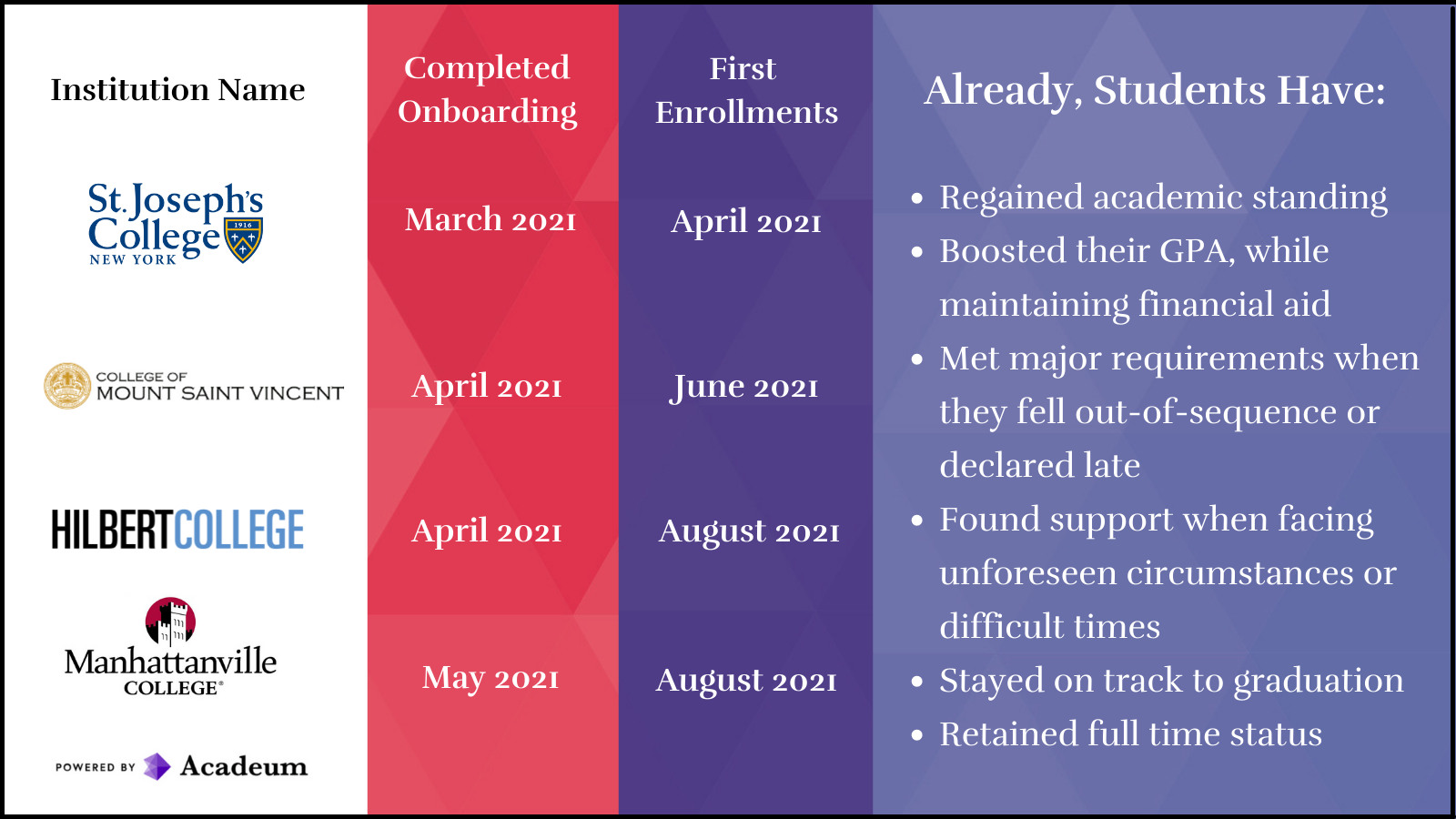Spotlight On: CICU Institutions
Colleges and universities that are just getting started with course sharing often ask us, How long does it take to get up and running? When will we start to see impact? Course sharing is unique in this regard—in only a few weeks, with minimal investment, schools can see early signals that it’s making a difference to students in need.
We spoke to course sharing leaders at four New York-based institutions within CICU (the Commission on Independent Colleges & Universities), who recently began their course sharing journeys, for a closer look at what “year one” of course sharing could look like. All schools joined Acadeum’s network through the CIC Online Course Sharing Consortium in 2021 and saw their first enrollments in shared courses in the same year.
Despite being relatively new to course sharing initiatives, these small liberal arts colleges report that they are already seeing positive outcomes related to student satisfaction. Here are just some of the ways schools have leveraged course sharing to help students, after only a few months:
Starting with Course Sharing: The Why
In our conversations with campus leaders, we found that many had similar reasons for joining a course sharing consortium. These schools pride themselves on offering a personal touch, keeping the student at the center, and solving problems—and they were interested in testing out how course sharing could further this student-centric approach.
President Michael Brophy of Hilbert College—which recently launched an ambitious program to convert 60% of its catalog to Quality Matters online courses—noted that it was “intuitive” to share these courses with other partner colleges and provide opportunities to students across the country.
The theme of opportunity surfaced repeatedly in our discussions. “Our students have been really grateful for course sharing,” said Jeneen Kelly, Registrar at Manhattanville College, which has seen early success in targeting students who risk falling behind in their studies, due to scheduling conflicts or poor performance in a course. “They see that we’re working with them to get them to the finish line. [Shared online courses] offer opportunities and an option for them to stay on track.”
“All students are online students,” said Brophy, in a conversation about this generation of students being particularly comfortable in online environments. “The more that we’re online, the better, because it’s meeting students where they are – and Acadeum helps us with that.” Kelly agreed that the “online piece is big for students.”
Other institutions echoed the sentiment that, early on, they recognized how course sharing could offer an effective solution on campus. Lynne Bongiovanni, Provost and Dean at College of Mount Saint Vincent recalls, “As soon as I learned about it, I realized how this could help fill some of the gaps we have with our students.”

Testing to Find What Works
When student needs surfaced, Bongiovanni and her team at Mount Saint Vincent often applied a pilot approach to see if course sharing could help address new challenges. “We had one student who was suspended after last spring, and she was desperate to come back,” she explained. “Our Dean piloted an approach, offering her two courses through [Acadeum’s] course sharing. She did well. Her GPA improved, and we’re bringing her back.”
Kelly at Manhattanville College noted that demonstrating the student impact helped everyone—from administrators to faculty—see what course sharing could accomplish. “One of our students was lacking a requirement for graduation. Staying an additional semester meant that she’d pay out of pocket—a significant burden on the student and her family.” The Associate Dean recommended that the advisor match the student with an online Acadeum course to ensure she could graduate on time.
Since those initial weeks, Kelly said she was surprised with how quickly Manhattanville was ramping up its use of course sharing. “[In April], we thought it was going to be one or two students—now at twelve enrollees, we’re moving very quickly.” Manhattanville has already approved 94 courses on the Acadeum network, which allows them to match a student to a course quickly and effectively when the need arises.
Sometimes, circumstances push institutions to get up and running faster than anticipated. When Becker College, facing a closure and teach-outs, needed a St. Joseph’s College biology course to support students on the cusp of graduation, the St. Joseph’s team had to mobilize quickly to start enrolling students—only eight weeks after joining the course sharing network.
“We were still finalizing [the process] to onboard students [as a Teaching Institution],” said Ashley J. Benson, St Joseph’s Associate Director of Online Programs. “Student services, student success, the registrar’s office, and admissions all came together.” Through strong leadership at St. Joseph’s, the team enrolled the students in need, filling empty course seats and helping seniors graduate from Becker College before the institution closed.
Finding the Right Students for Course Sharing
The CICU schools we spoke to described how their teams were already establishing best practices to find students who could most benefit from course sharing.

“We looked at the top 30 courses students enrolled in across Acadeum,” said Brophy at Hilbert. “We noticed a strong need for Music electives; as a result, one of our faculty developed five music courses online that will be available to our students and to others. We identified a need and saw that we excelled there.”
Hilbert College is currently a Teaching Institution on the Acadeum platform, offering courses to other partner institutions—in the coming months, they are expanding their impact by becoming a Home Institution to help their students find specific courses they need to progress or graduate. President Brophy acknowledged that it’s “very comforting” to know the courses offered across the network are of the highest quality.
Year 2 and Beyond
Schools are already looking ahead to see how course sharing can address additional student needs. Manhattanville College plans to propose course sharing for grade replacement to their governing committees as the next strategy to help students, while Mount Saint Vincent is working to solidify processes around students facing suspension/probation. “We’re asking ourselves ‘what sort of criteria will we use as a form of appeal for that academic standing?’” said Bongiovanni.
Hilbert College is focused on enrolling students for the 2021 Winter Term and looks forward to expanding impact in the future to launching new programs: “Given the similarity of the missions within CICU, and further along with CIC schools, it will be easier to think about creating dual degree programs,” said Brophy.
All schools said they were excited to see how course sharing could continue to solve student problems, harkening back to their mission to prioritize personal attention and support. “The student sees us helping them,” said Kelly. “And that’s what they’re going to remember.”
Best Practices for Course Sharing Year 1: Tips from CICU Institutions
Þ Take time to have internal conversations about course sharing benefits: access, opportunity, progress, and how it can help students when they’re struggling.
Þ Focus on transparency: Communicate new processes and the “why” of course sharing clearly to on-campus teams.
Þ Finalize administrative processes and steps before taking course sharing to the faculty board to discuss expanded strategies and tactics.
Þ Share stories! Talk with other institutions about how they’re using course sharing to identify similar strategies and spark new ideas.
Þ Identify barriers for student progress at your institution–then, work with your Acadeum account manager to implement the right course sharing solution.









